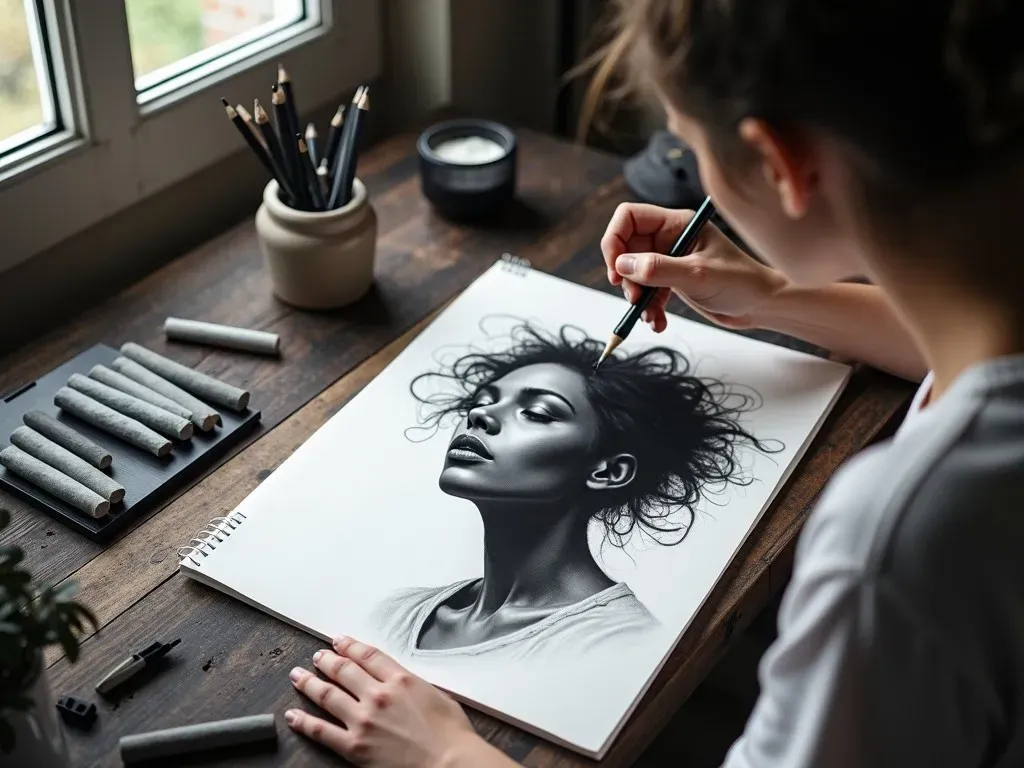When we think of painting, we typically picture brushes and vibrant colors. However, there’s a unique and striking alternative that artists are increasingly turning to—painting with charcoal. This method allows for rich textures, deep contrasts, and an expressive quality that traditional painting methods sometimes can’t achieve. With its versatility, charcoal can be used on various surfaces, including canvas, making it an exciting option for painters looking to explore new Techniques.
What is Charcoal Painting?
Charcoal painting is an artistic technique that harnesses the rich, dark quality of charcoal combined with various supports like paper or canvas. Artists use charcoal not just for drawing but also for painting, creating expressive pieces that often exhibit a moody, atmospheric quality. Whether you prefer working with compressed charcoal sticks or natural vine charcoal, the possibilities are endless.
Charcoal on Canvas: A New Frontier in Art
Painting with charcoal on canvas can result in stunning artwork that speaks volumes. The texture of the canvas provides an intricate backdrop for the smooth application of charcoal. This technique allows for rapid mark-making and an innate ability to blend and layer, giving your artwork a dynamic appearance.
Benefits of Charcoal painting on canvas
- Textural Possibilities: The rougher surface of canvas can absorb the charcoal differently than paper, offering texture that can’t be replicated.
- Ease of Blending: Unlike some oil paints, charcoal is easily blended, allowing for smooth transitions and soft lines.
- Expressive Qualities: Charcoal can achieve extraordinary contrasts, giving depth and dimension to your artwork.
Charcoal Drawing on Canvas: Techniques and Tips
Learn to master the basics before diving into detailed work. Here are some techniques that can develop your skillset:
Basic Techniques for Painting with Charcoal
- Layering: Start with a light application of charcoal and gradually build up layers to achieve depth.
- Blending: Use a blending stump or your fingers to soften lines and create gradients.
- Erasing: Make use of kneaded erasers to lift charcoal and create highlights, enhancing the contrast in your work.
Interesting Facts About Charcoal Painting
| Fact | Description |
|---|---|
| Origin | Charcoal has been used in art since prehistoric times. |
| Versatility | It can be used on various surfaces, including paper, wood, and canvas. |
| Environmental Impact | Charcoal production can be sustainable when sourced responsibly. |
| Color Options | There are various types of charcoal, including vine charcoal and compressed charcoal, each offering unique qualities. |
Working With Charcoal Paint
Charcoal can be mixed with various mediums to create unique finishes. While traditional oil or acrylic paints provide their own advantages, charcoal can serve as an underdrawing, giving your artwork a foundational element that can be painted over or left visible intentionally.
Essential Supplies for Charcoal Painting
- Charcoal Sticks: Choose from different hardness levels based on your desired darkness.
- Canvas: Use prepared canvases for better adhesion and texture.
- Fixative: Spray fixative to secure your artwork and prevent smudging. A great option is Sennelier Fixative.
- Blending Stumps: For smooth transitions.
Advanced Techniques for Charcoal Artistry
Once familiar with the basics, try these advanced techniques to elevate your artwork:
- Texture Creation: Drape textile or use various tools to create patterns in the charcoal.
- Color Integration: Consider mixing charcoal with colored pastels to broaden your palette.
- Multi-Media: Combine charcoal with paints, ink, or other materials for mixed-media masterpieces.
FAQs About Painting with Charcoal
1. Can I use charcoal on any type of canvas?
Yes, charcoal works on primed canvas as well as unprimed canvas.
2. How do I prevent my charcoal artwork from smudging?
Using a fixative can help to seal the charcoal and reduce smudging, but be careful not to over-apply it, as it can alter the appearance of your artwork.
3. Is charcoal painting suitable for beginners?
Absolutely! Charcoal is user-friendly, making it an excellent medium for beginners to experiment with line and texture.
4. Can I combine charcoal with other mediums?
Definitely! Charcoal combines well with pastels, ink, and even watercolor, giving you the freedom to explore your creativity across different styles.
Conclusion
By experimenting with painting techniques using charcoal, artists can explore a new dimension of their creativity. Whether you’re an experienced painter or a beginner, there’s much to explore in the world of charcoal art.
For more insights into drawing and painting techniques, consider exploring resources such as Fine Art Tutorials and expand your horizons even further.
Once you start to paint with charcoal, you’ll discover a fascinating medium full of potential and beautiful results. Your artistic journey awaits!
